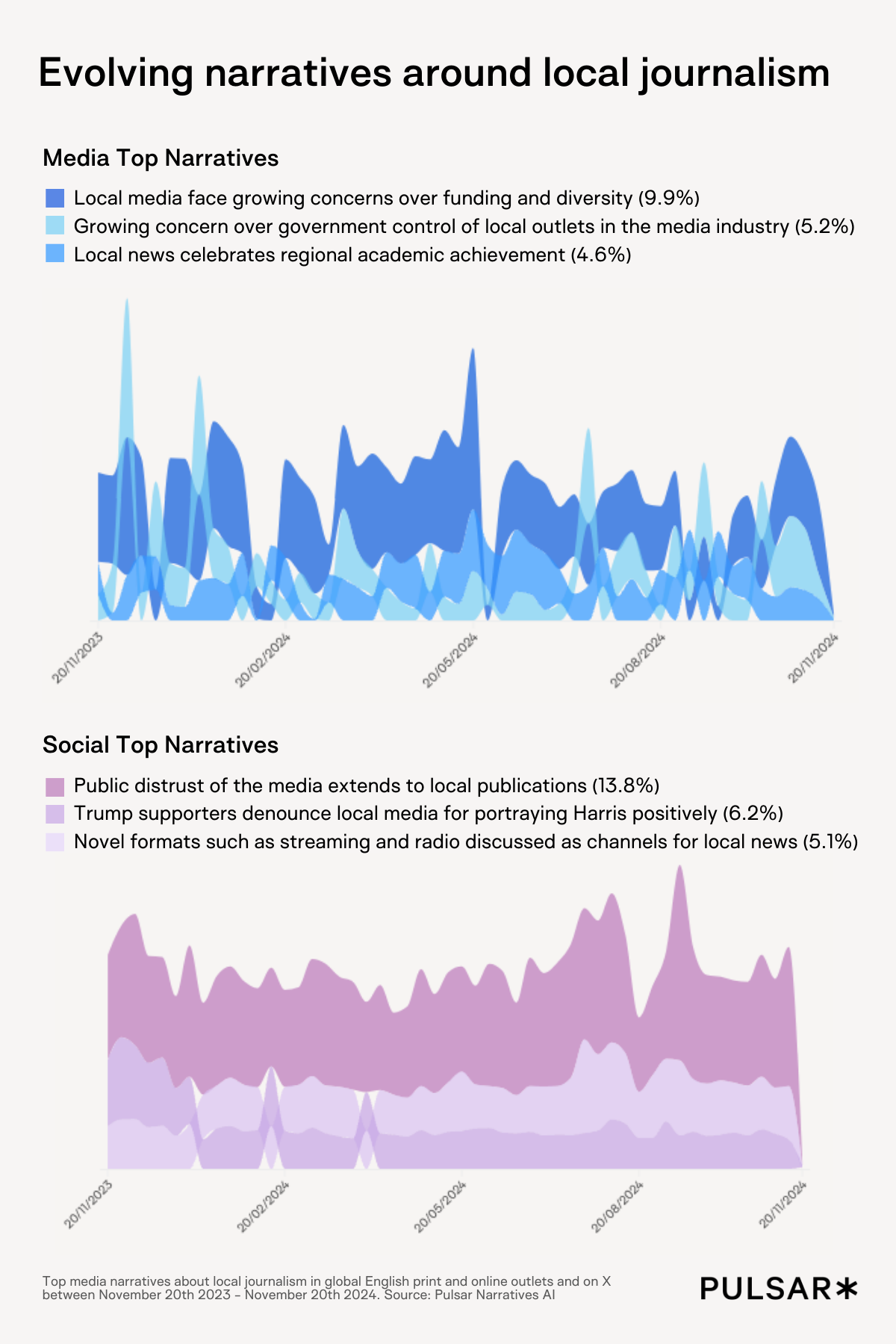
Local journalism still has an audience – just not always the one you expect
- Media & Entertainment
As audience’s news consumption habits rapidly evolve, local journalism is often cast as the victim. And for the most part this reflects a longstanding reality, with declining readerships and budgets appearing to tell a story of an industry in terminal decline.
The story has grown more nuanced in recent years, however. That is not for one moment to claim that local journalism is in excellent health – the reliable audiences and near monopoly many publications enjoyed in the 20th century are gone, never to return.
But analyzing the social, audience and media data around local journalism across the world suggests a picture more nuanced than any surface reading might indicate, with new relationships, communities and champions emerging to complicate the picture of an industry on its last legs.
Man, I love local journalism
byu/Johan_Sebastian_Cock inJournalism
Naturally, this matters to the media organisations themselves, and has a profound civic impact. Beyond that, it also has implications for the marketers, PR and comms pros tasked with reaching different audiences. Might this one channel have more utility – and potential – than previously thought?
We can immediately test this hypothesis by using Pulsar's Narratives tool, which uses AI clustering and segmentation to surface the narratives playing out in public and media discussions, to view which are associated with local journalism.
What does this tell us? For one thing, that the media is most concerned about the ability of local journalism to fund itself. To some degree this is predictable, with the media class both more knowledgeable on the funding models of journalism and possessing 'skin in the game'. At the same time, it's striking that the predominant public narratives are centered on local journalism being used to wield political influence. This narrative is critical, but it presupposes that local journalism is an influential channel worth fighting for control over.
@Local12 may be time to find a new local news source with your spreading of half truths and misconstruing Trump’s words about Liz Cheney. Be better! Your journalism has slipped. Your bias is showing!
— Jimmy Dinsmore (@driversside) November 1, 2024
Two other notable narratives emerge. In the media, local journalism is often used to share local academic achievements and initiatives. As many countries across the globe rethink the relationship of children and schools to social media, the trust (and contained audiences) cultivated by local publications mean that it will likely remain a key channel for institutions, proud parents, and communities eager for good news stories.
On social, meanwhile, we see local journalism increasingly associated with livestreams, digital radio shows and novel channels. We'll return to discuss the most notable of these shortly, but it underlines that the medium is not wedded to traditional formats such as print and television. And that while technology had a deeply negative impact on audiences in the earlier part of the 21st century, more recent years have seen solo or small scale enterprises empowered by its creative and audience-building capabilities.
Of course, a macro-view can only ever give a partial view of a hyper-localised medium. To understand how local journalism is constantly evolving, and looking to engage its audiences, we can look at first at West Suffolk – a rural area of the UK with very little industrial or cultural prominence in the UK at large beyond Greene King and the Newmarket Races.
According to Public Interest News, the area is not one of the 'news deserts' that are cropping up across the UK and US, boasting a comparatively high number of outlets per 100,000 people. However, the circulation of these local papers has been in vertiginous decline, leaving titles such The East Anglian Daily Times (which prints editions across the county), scrambling to find sustainable business models.
When we map every instance in which audiences or other media mention local titles, a clear pattern emerges.
Local publications have invested heavily in covering Ipswich Town, the local football club –so much so that this data required plotting on a logarithmic scale so as to fit the club into the same visualization. And this in a year that saw a general election campaign play out and unseat several incumbents within the region.
Promotional campaigns in the region make the link explicit, with papers seeking to adopt a business model similar to that of The Athletic: fandom compels supporters to buy subscriptions for increased access to (and speculation around) a local sports team.
The upsides to this appear twofold: increased relevance amongst local communities who may have let their readership lapse, and the potential expansion of an audience beyond narrowly-defined county lines.
Working out the efficacy of the latter strategy requires close reading, however, as not all engagement is equal. For instance, the high level of outside migration the county sees amongst its young people means there is a potential network of fans ready to be connected and served a diet of digital content. At the same time, explosions of interest in regions like Indonesia can accrue benefits around SEO and traffic, but are less likely to evolve into the kind of subscription behavior that can financially underwrite other aspects of local journalism.
Why does this matter to other publications? After all, none can prompt their local sports team to go on an almost unprecedented run of success.
But it does highlight two interesting dynamics – first that of engaging an expat or region-curious community of readers, and secondly that of finding a niche which can generate enthusiasm amongst a local community, whether related to local sports, culture, institutions or some other cause.
Of course, traditional media pivoting to meet emergent needs is only part of the picture. The rise of Substack has corresponded to more opportunities for local journalists to either strike out on their own, or create start-up style publications.
I just want to call out Conor Durkin (@ConDurkin) for his outstanding Substack on politics and policy in Chicago.
We have way, way too little policy journalism on local governments. Thus only the insiders even know what is happening, often.
I wish we had a Conor in every city. pic.twitter.com/b6efHGyz0B
— Dean W. Ball (@deanwball) October 9, 2024
Many of Substack's highest profile contributors have built international audiences. However, a potentially overlooked element of the platform's rise is the space it affords local journalists, many of whom have struck out from larger publications to address what they believe to be an unmet need.
As the above example indicates, however, these efforts appear largely concentrated in urban areas. This is due to both the larger numbers of potential readers in centres densely populated by largely younger, more tech-literate audiences, but also due to the paucity of existing coverage in many such localities.
This is a sensation we've observed in Substack's own home state of California, but also as far afield as Toronto, London and Manchester. Rivals to Substack like Ghost, meanwhile, also play host to local activist journalism, such as 'We The Citizens' in Singapore.
Clearly these newsletters each rely on their email lists for distribution. More interesting is how they look to grow those audiences via social platforms, including Threads, Instagram, X, Bluesky and more. Analysis into The Mill, conducted with our sister company Vuelio, would emphasise the role played by staff journalists and editors in disseminating news articles, aided and abetted by a shifting case of local authoritative voices and figures from the national press.
The only thing certain about local journalism is that there is no going back to the way things were. And many strategic pivots or new enterprises simply won't find the audiences they need. But there is enough invention, popular support and community-building taking place within the space to suggest local journalism, in one form or another, will remain worth paying attention to – for audiences, but also for any who wish to reach those audiences
For more insights, from the world of media as well as behavioral and trend data from myriad different categories, you can sign up to our regular insights newsletter using the link below.



